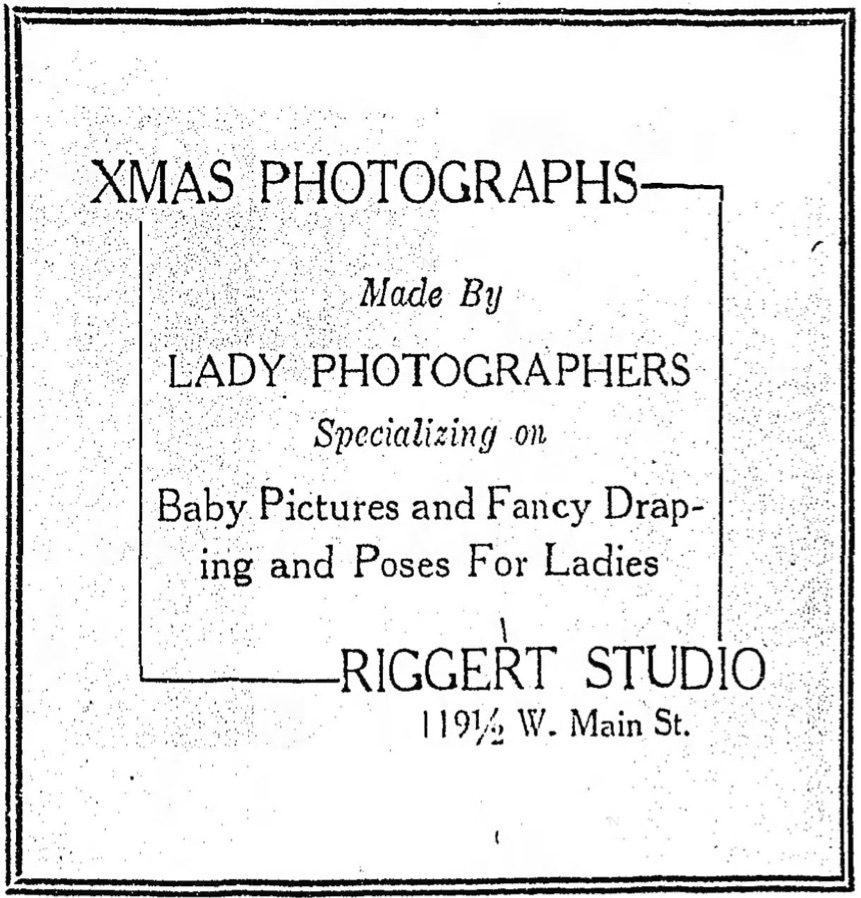This is the first of a four-part series.
“XMAS PHOTOGRAPHS Made by LADY PHOTOGRAPHERS”

The Daily Oklahoman 1922-12-23, p. 36. Credit: Newspapers.com
While there’s lots to consider in that ad from 1922 for the Riggert Studio, what I want to point out is the prominent phrase “LADY PHOTOGRAPHERS.”
Back in the very first post on this blog, I showed that in the collection of newspapers on Newspapers.com, the word lady was the most common of the three descriptors for women (woman and female being the other two). I also included at the end a couple links, provided by Will Leben, that discuss the sometimes negative connotations of lady and problems with its current use as a modifier. While that commentary is reasonable, I am interested in how lady photographer was used and likely perceived by people in the time frame of our Early Women Artisan Photographer (EWAP) project (1840-1930).
In the ad above, the Riggert Studio is touting the fact that the photographs will be made by “lady photographers,” so we can infer that women photographers were considered to be a positive. Not just women photographers, but lady photographers. Note that this ad is from 1922, it is not “just” a 19th century archaism, though not surprisingly photographers in the 1800s also touted their lady photographers:

Linn County Clarion 1884-04-11, p. 3. Credit: Newspapers.com
In both of these ads, the names of the photographers are not mentioned. It is enough for the readers to know that they are lady photographers. The Dewey studio is run by George F. Dewey, and there is no evidence that his wife Mary was ever a photographer. That doesn’t mean she wasn’t, just that we don’t know whether we was or not.
The Riggert Studio is more complicated. John H Woods had been running it for several years, and he was a prize winning photographer, according to earlier ads. However, he dies about June of 1922, so 6 months before that ad runs. It’s not clear who is running the Riggert Studio at that point. It could be his wife Adda, but in 1923 Philip O’Meara has a studio at that address. He had a studio at a different address in 1922. He gets married in June of 1922 to Dovie Montgomery, but again, there’s no evidence that she was a photographer. So we still don’t know who the lady photographers were at the Riggert Studio in 1922. That’s how it goes sometimes with EWAP research.
There are other ads which do name the lady photographer. This ad featuring Mrs F.G. Harris is particularly interesting:

Asheville Citizen-Times 1918-06-23, p. 2 Credit: Newspapers.com
This ad isn’t for a photographer or a studio, but rather for Peplac, a “reconstructive tonic” which is “composed of elements that are purely vegetable, it is said, free from mineral taint” according to a puff piece article when Peplac was introduced the previous year. It would fit right in on the shelves around here a hundred years later.
As for Mrs F.G. Harris, she was Louvenia “Vennie” Harris who seems to have been the only woman photographer running her own studio in Raleigh, North Carolina at that time, as the owner of the Acme Studio, and she seems to have been in business for just a couple years. Her husband was Floyd G., who had been a photographer himself earlier (he’s in the 1910 Census as one), but who was a carpenter at this point.
But our point is that a lady photographer was deemed a good person to promote Peplac. Now that is a testimonial to lady photographer!
In part 2, we’ll look at lady photographer in the news.